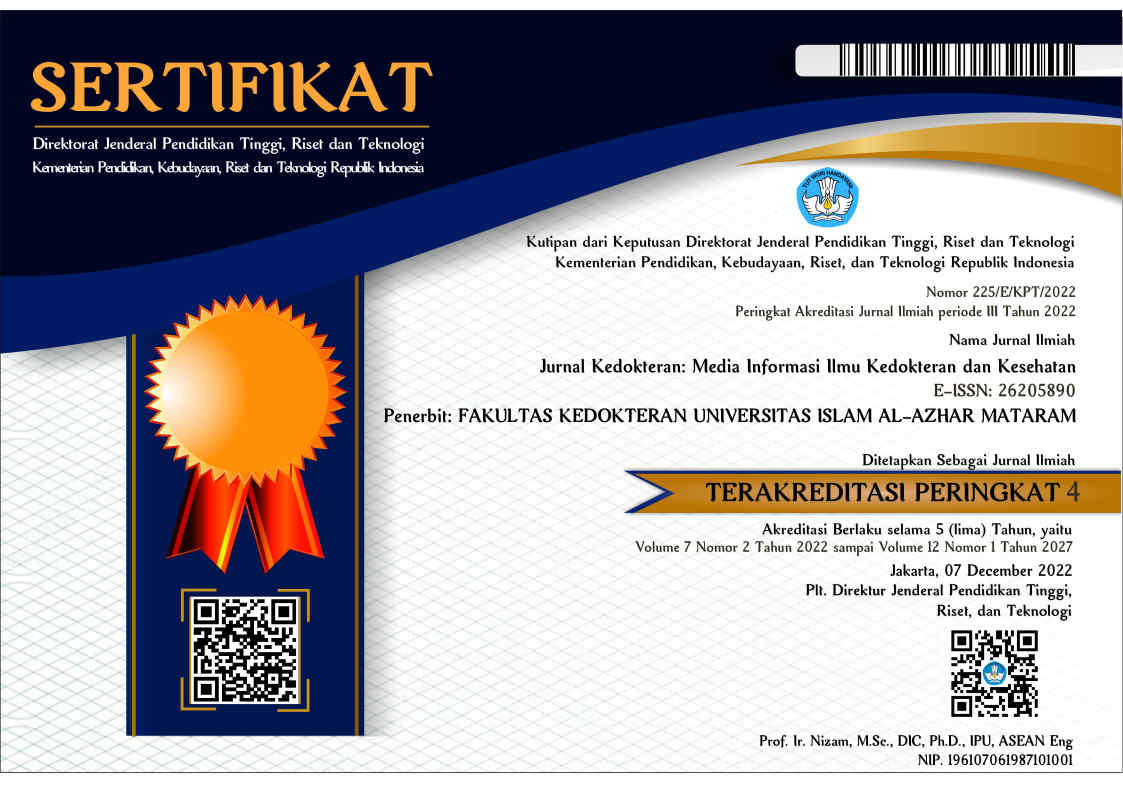Description of Stroke Prevention Behavior in Hypertensive Patients at the Bebandem Health Center, Karangasem Regency in October 2022
DOI:
https://doi.org/10.36679/kedokteran.v9i1.44Keywords:
Hypertension, Stroke, PreventionAbstract
Hypertension is a disease that is often called the silent killer. Uncontrolled hypertension will cause complications such as heart disease, stroke, and kidney failure. Stroke is the third leading cause of death. Prevention is one of the most effective and efficient ways to reduce the incidence of stroke. Hypertension is a risk factor for stroke, and controlling hypertension can reduce the incidence of stroke. The purpose of this study was to find out the description of stroke prevention behavior in hypertensive patients at the Bebandem Health Center, Karangasem Regency, in October 2022. This research is a descriptive study using a cross-sectional research design. The research sample used outpatients who were blood pressure checked that met the inclusion and exclusion criteria at the Bendadem Karangasem Health Center in October 2022 with a sample size of 67 respondents. The results of the study: The characteristics of the respondents studied can be described based on age (38.8%) aged 30-39 years, gender (53.7%) male, education (46.3%) last educated, namely Senior High School / Vocational School. Based on stroke prevention behavior, it has found that the majority (58.2%) had good stroke prevention behavior.
References
Anom, N. G. (2021). PROFIL KESEHATAN PROVINSI BALI. Dinkes Bali.
Arum, Y. T. G. (2019). Hipertensi pada Penduduk Usia Produktif (15-64 Tahun). Higeia Journal of Public Health Research and Development, 1(3), 84–94.
Aune, D., Huang, W., Nie, J., & Wang, Y. (2021). Hypertension and the Risk of All-Cause and Cause-Specific Mortality: An Outcome-Wide Association Study of 67 Causes of Death in the National Health Interview Survey. BioMed Research International, 2021, 10. https://doi.org/10.1155/2021/9376134
Ayu, D., Sinaga, A. F., Syahlan, N., Siregar, S. M., Sofi, S., Zega, R. S., Annisa, A., & Dila, T. A. (2022). Faktor - Faktor Yang Menyebabkan Hipertensi Di Kelurahan Medan Tenggara. Jurnal Kesehatan Masyarakat (Undip), 10(2), 136–147. https://doi.org/10.14710/jkm.v10i2.32252
Depkes RI. (2014). Buku Pedoman Teknis Penemuan dan Tatalaksana Penyakit Hipertensi. In Kementerian Kesehatan RI (viii).
Harsismanto, Andri, J., Payana, T. D., Andrianto, M. B., & Sartika, A. (2020). Kualitas Tidur Berhubungan dengan Perubahan Tekanan Darah pada Lansia. Jurnal Kesmas Asclepius, 2(1), 1–11. https://doi.org/10.31539/jka.v2i1.1146
Husnaniyah, D., Hidayatin, T., & Handayani, E. J. (2021). Perilaku Pencegahan Stroke Pada Penderita Hipertensi di Wilayah Kerja Puskesmas Jatibarang Indramayu. Medika Cendikia, 8(1), 1–52. https://doi.org/https://doi.org/10.33482/medika.v8i1.135
Hustrini, A. A. L. E. H. N. M. (2019). Konsensus Penatalaksanaan Hipertensi 2019. In Indonesian Society Hipertensi Indonesia.
Maringga, E. G., & Sari, N. I. Y. (2020). Analisis Faktor yang Mempengaruhi Kejadian Hipertensi Pada Wanita Menopause di Desa Kayen Kidul Kecamatan Kayen Kidul Kabupaten Kediri. Jurnal Kebidanan, 6(2), 21–25. https://doi.org/10.21070/midwiferia.v
Notoatmodjo, S. (2011). Kesehatan Masyarakat Ilmu & Seni (Revisi). Rineka Cipta.
Pebrisiana, P., Tambunan, L. N., & Baringbing, E. P. (2022). Hubungan Karakteristik dengan Kejadian Hipertensi pada Pasien Rawat Jalan di RSUD Dr. Doris Sylvanus Provinsi Kalimantan Tengah. Jurnal Surya Medika, 8(3), 176–186. https://doi.org/10.33084/jsm.v8i3.4511
Potter, & Perry. (2005). Buku Ajar Fundamental Keperawatan Vol. 1 Ed. 4 (4th ed., Vol. 1). EGC. http://oasis.iik.ac.id/library/index.php?p=show_detail&id=3941
Rahmawati, D., Kurniawan, T., & Hartati, S. (2019). Gambaran self-management pada pasien stroke sang mejalani rawat jalan. Jurnal Ilmu Kesehatan, 6(6), 13–25. https://journal.unisa-bandung.ac.id/index.php/jka/article/view/117
Safitri, W., & Agustin, W. R. (2020). Pengetahuan dengan Motivasi Pencegahan Stroke pada Penderita Hipertensi. Adi Husada Nursing Journal, 6(1), 45. https://doi.org/10.37036/ahnj.v6i1.160
Salsabilla, N., Puspitasari, P., Haqi, D. N., Rofiq, A., & Wulandari, R. D. (2022). ANALYSIS OF WORK MOTIVATION AND WORK DISCIPLINE OF EMPLOYEE AT WIYUNG SEJAHTERA HOSPITAL SURABAYA. IJPH, 17(2), 95–105.
Singh, P. K. (2021). Hari Stroke Sedunia. In WHO (pp. 1–2). https://www-who-int.translate.goog/southeastasia/news/detail/28-10-2021-world-stroke-day?_x_tr_sl=en&_x_tr_tl=id&_x_tr_hl=id&_x_tr_pto=tc
Utama, Y. A., & Nainggolan, S. S. (2022). Faktor Resiko yang Mempengaruhi Kejadian Stroke: Sebuah Tinjauan Sistematis. Jurnal Ilmiah Universitas Batanghari Jambi, 22(1), 549. https://doi.org/10.33087/jiubj.v22i1.1950
Yunus, M., Aditya, I. W. C., & Eksa, D. R. (2021). HUBUNGAN USIA DAN JENIS KELAMIN
DENGAN KEJADIAN HIPERTENSI DI PUSKESMAS HAJI PEMANGGILAN KECAMATAN ANAK TUHA KAB. LAMPUNG TENGAH. Jurnal Ilmu Kedokteran Dan Kesehatan, 8(3), 192–201. https://journals.ekb.eg/article_243701_6d52e3f13ad637c3028353d08aac9c57.pdf
Downloads
Published
How to Cite
Issue
Section
License
Copyright (c) 2023 Grantika Nugraha

This work is licensed under a Creative Commons Attribution-NonCommercial 4.0 International License.







